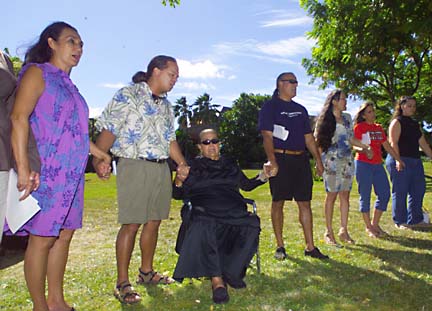Group opposes museum plan
Hui Malama does not want Bishop Museum defined as a native Hawaiian organization
Honolulu Star-Bulletin
Wednesday, September 1, 2004
RICHARD WALKER /
RWALKER@STARBULLETIN.COM
A group of native Hawaiians chanted before a news conference yesterday on the Bishop Museum front lawn.By Sally Apgar
sapgar@starbulletin.comA group of native Hawaiians stood on the front lawn of Bishop Museum yesterday and reiterated their call for the resignation of the museum's director.
The group opposes the museum board's proposed "interim guidance policy," announced earlier this summer in which the museum defined itself as a native Hawaiian organization under the terms of the Native American Graves Protection and Repatriation Act of 1990. NAGPRA was enacted to provide procedures for museums to return ancestral bones and four classes of objects to Native Americans and Hawaiians.
"This is extremely colonial and paternal," said Edward Ayau, describing the proposed policy. Ayau is a spokesman for Hui Malama I Na Kupuna O Hawaii Nei, founded in 1988 to care for ancestral remains, sacred objects and burial sites.
Federal authorities are investigating the alleged black market sale of items that Bishop Museum and the Peabody Essex Museum in Massachusetts repatriated to Hui Malama for reburial in two Big Island caves. Hui Malama acknowledged last week that repatriated items were taken from one of the caves.
Ayau said NAGPRA was "human rights legislation" designed to right wrongs of the past in which human remains were displayed in museums. He said NAGPRA never intended for museums, which have acquired human remains of ancestors from burial caves, to stand as a native Hawaiian organization.
Ayau said the intent of NAGPRA was "to heal historic wounds, and this (interim policy) opens them."
RICHARD WALKER /
RWALKER@STARBULLETIN.COM
Lilikala Kame'eleihiwa gave a statement yesterday as Frenchy DeSoto listened during a news conference.Participating in yesterday's news conference were about 20 native Hawaiians, including kupuna and former Office of Hawaiian Affairs trustee Frenchy DeSoto, members of Hui Malama, and Lilikala Kame'eleihiwa, a professor with the University of Hawaii's Center for Hawaiian Studies.
DeSoto called the museum's policy "an outrage. We want freedom of religion and there is no freedom of religion for us."
In addition to calling for Museum Director William Brown's resignation because of the policy, the group presented a petition with several hundred signatures protesting it.
Brown declined to comment. A museum official present at the news conference also declined to comment.
Since announcing the museum board's proposed policy, the museum has been taking public comments and is expected to make a final decision in September. NAGPRA's National Review Committee is also expected to review the legality of the precedent-setting policy in its Sept. 17-18 meeting in Washington, D.C. (The guidance policy is on the museum Web site at www.bishopmuseum.org/NAGPRAGuidlines.html.)
In the past, Brown has said that the museum's founding mission fits within NAGPRA's legal definition of a native Hawaiian organization.
The museum was founded in 1889 by Charles Reed Bishop as a memorial to his wife, Princess Bernice Pauahi Bishop, the last of the Kamehameha line of ruling chiefs. The museum's core collection included items owned by Pauahi, Princess Ruth Keelikolani, Queen Emma and Queen Liliuokalani. The museum was charged with being a steward of the collections for future generations.
Based on its founding mission, Brown has argued that the museum is a native Hawaiian organization under NAGPRA because it "serves and represents the interests of native Hawaiians" and "has expertise in native Hawaiian affairs." In 2003, the museum also amended its bylaws to cover another criteria of NAGPRA that such an organization has as a "stated purpose the provision of services to native Hawaiians."
But Ayau said yesterday that if the museum proclaims itself a native Hawaiian organization "it causes an inherent conflict of interest. How can they be both a claimant and a museum?"
The museum has said that it would be on an equal footing with other native Hawaiian organizations. A federal judge has ruled that consensus among native Hawaiian organizations must be reached on the disposition of artifacts. The museum has said it would be one voice in that consensus.
But Ayau and others claim the museum has an unfair advantage: If an object now held in the museum is disputed, it remains with the museum. Ayau says they could dispute any item and it would remain at the museum. The only recourse is to take it to federal court.
Ayau said that with this proposed policy, "The museum is saying that native Hawaiians are not competent to take care of their ancestors and their moepu (objects buried with human remains)."
Several native Hawaiians also attacked the notion of what the museum calls burial objects.
Vicky Holt Takamine, a kumu hula and a Hawaiian cultural activist, said: "What if I want to be buried with my red shoes? In 100 or 150 years from now, does some archaeologist say they are not burial items" and can therefore be in a museum?
Original article URL: http://starbulletin.com/2004/09/01/news/story6.html
Ho`iho`i Mai
Return

